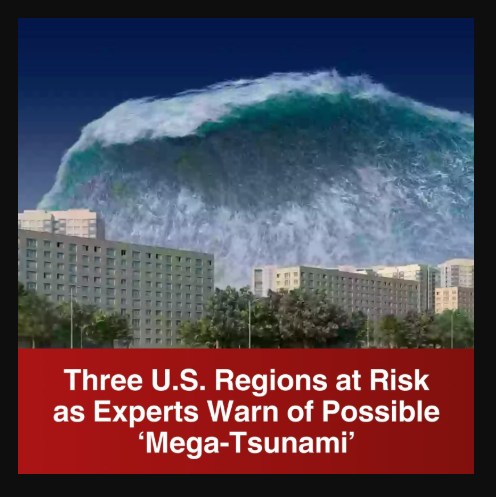Scientists have pinpointed three major regions in the United States that face significant risks from tsunamis and flooding, making it crucial for residents and officials alike to understand the dangers and prepare accordingly. These regions are the Pacific Northwest, the East Coast, and the Gulf Coast, each with its own unique vulnerabilities linked to geological activity and environmental changes. Collectively, they represent the most deadly tsunami zones in the country, where natural forces can combine to create life-threatening situations. Understanding the risks these areas face is essential for enhancing public safety and reducing potential damage.

The main threats to these coastal zones come from a combination of earthquakes, underwater landslides, and rising sea levels—a problem that has only intensified due to climate change. Tsunamis, massive ocean waves triggered by sudden disturbances such as earthquakes or landslides, can travel at astonishing speeds across the sea. As they approach shallow coastal waters, their waves grow dramatically in height, often resulting in catastrophic flooding of shoreline communities. The speed and size of these waves leave very little time for warning and evacuation, making awareness and preparation a matter of life or death.
Among the three regions, the Pacific Northwest is considered the most vulnerable. This area sits atop the Cascadia Subduction Zone, a massive fault where the Juan de Fuca tectonic plate is slipping beneath the North American plate. Experts estimate that there is a significant chance—about 37 percent—that a major earthquake will strike this region within the next 50 years. Such an event would likely trigger a powerful tsunami that could devastate coastal towns and cities in Oregon, Washington, and parts of northern California. Given the proximity to this seismic hotspot, residents could have only minutes to evacuate before a tsunami wave crashes ashore, which is why emergency preparedness efforts have been a top priority in the region. Local governments have been working hard to establish clear evacuation routes and improve early warning systems to save as many lives as possible when the inevitable quake and tsunami strike.
The East Coast, although less prone to frequent seismic activity than the West Coast, faces its own serious tsunami threats. The risk here largely comes from distant underwater landslides and earthquakes, particularly those occurring along the Caribbean fault line. While major earthquakes are relatively rare in this part of the country, the geological faults in the Atlantic Ocean and Caribbean Sea can generate tsunami waves that travel great distances, potentially impacting coastal cities from Florida to New England. The East Coast’s low-lying geography makes it especially susceptible to flooding, and the presence of highly populated urban areas only increases the potential for disaster. In addition, tsunamis hitting this region could coincide with hurricane-related flooding, further complicating emergency responses.
Though the Gulf Coast’s tsunami risk is generally lower compared to the Pacific Northwest and East Coast, it is not without vulnerabilities. This region’s flat coastal plains and history of underwater landslides make it susceptible to tsunami events, particularly when combined with rising sea levels and intensified coastal erosion. The Gulf Coast frequently experiences hurricanes and tropical storms, which already pose significant flooding risks. The added threat of tsunami waves, even if less common, should not be overlooked by communities in Texas, Louisiana, Mississippi, Alabama, and western Florida. These areas remain at risk of severe flooding and damage, reinforcing the importance of disaster preparedness for all types of coastal hazards.
A major challenge with tsunamis is the very limited warning time available, especially for those triggered by nearby earthquakes or landslides. In many cases, residents near the epicenter might only have a few minutes to respond before the tsunami arrives. For this reason, scientists and emergency management officials emphasize the importance of personal awareness. If you are near the coast and experience a strong earthquake or notice the ocean suddenly receding—known as a “drawback”—these are urgent signals to evacuate immediately to higher ground without waiting for official alerts. Acting quickly can save lives.
Climate change has only heightened these risks by causing sea levels to rise and accelerating coastal erosion. Higher seas mean that tsunami waves and storm surges can travel farther inland, causing more extensive flooding and damage than in the past. Natural barriers that once helped protect coastlines are diminishing, and communities must adapt to these changing conditions to stay safe.
Scientists, emergency planners, and government agencies continue to work on improving tsunami detection systems, refining evacuation procedures, and educating the public about these hazards. While it’s impossible to eliminate the risk entirely, increased awareness and preparation can significantly reduce the impact of future tsunami events.
In summary, the Pacific Northwest, East Coast, and Gulf Coast all face distinct yet serious risks from tsunamis and flooding due to earthquakes, underwater landslides, and rising sea levels. Being aware of these dangers, recognizing early warning signs, and following evacuation protocols can make the difference between life and death. As scientists advance safety measures and public education, communities across these regions are encouraged to stay vigilant and prepared to protect themselves from these powerful natural threats.





